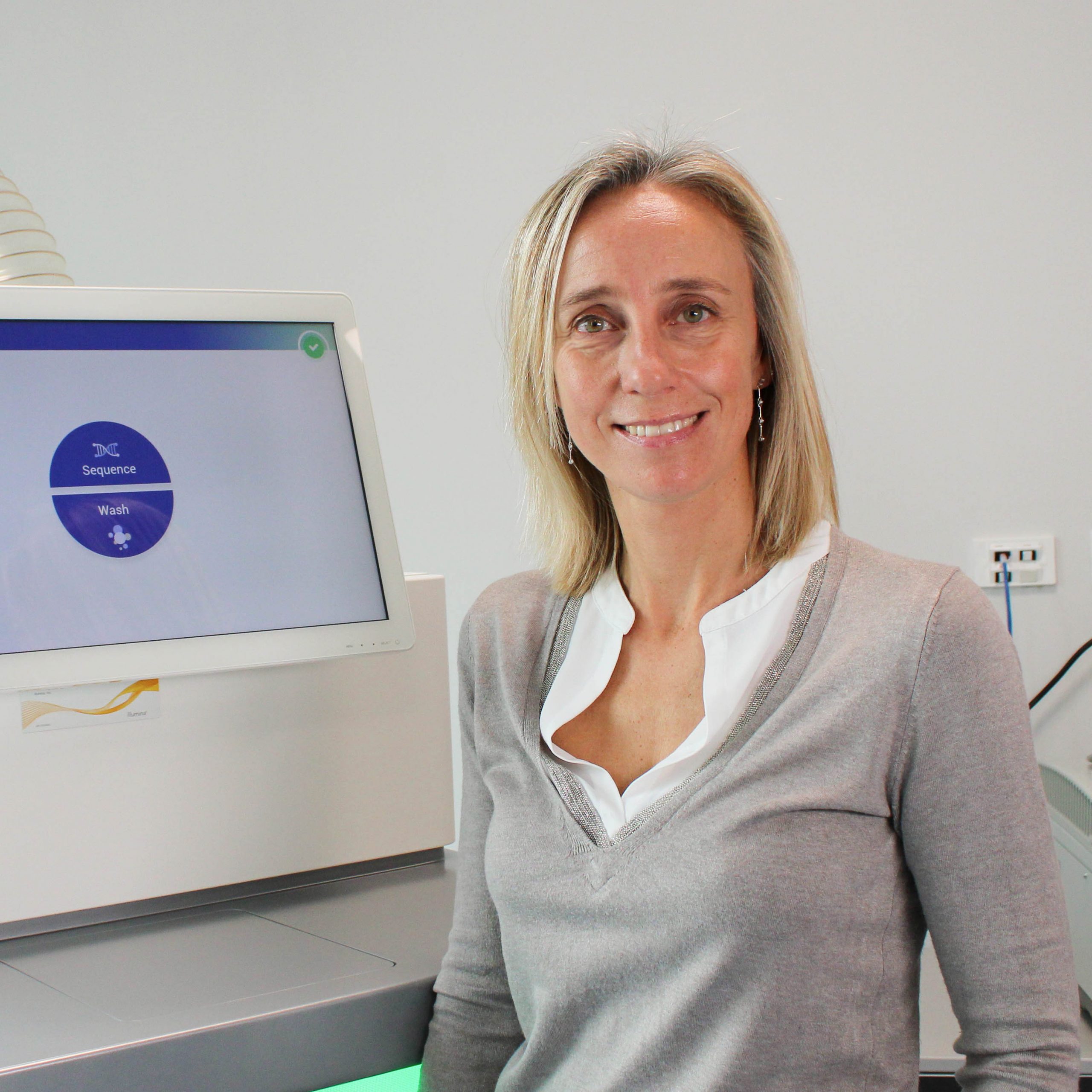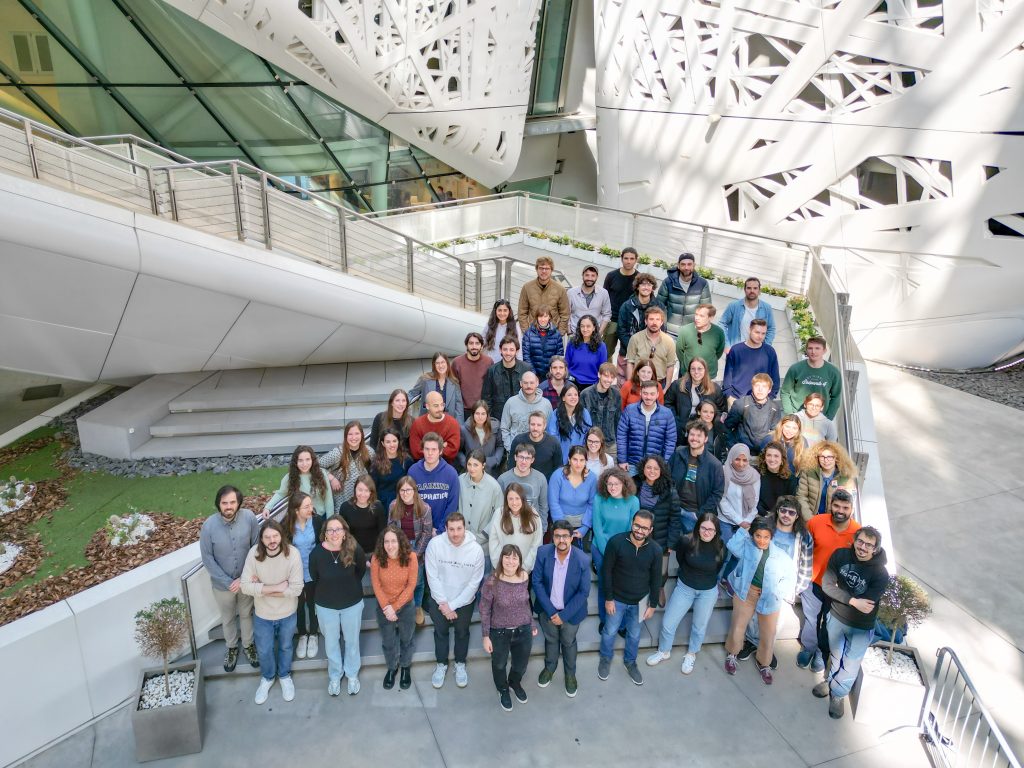The National Facility for Genomics with Clelia Peano

Meet Clelia Peano, Head of the National Facility for Genomics. The Facility offers cutting-edge services to develop robust experimental and analytical workflows to explore different genomic research areas, including DNA and RNA analysis, chromatin structure, and epigenetic mechanisms regulating transcription. The goal is to enhance genomic research in all its aspects, benefiting the entire Italian scientific community.
Clelia, tell us about your background: what inspired you to pursue a career in life sciences research?
My educational journey began with a deep fascination for biology during my high school years, which led me to pursue a degree in molecular biology at the University of Parma. During my undergraduate studies, I was particularly captivated by genetics and the potential it holds for understanding the complexities of life. Throughout my PhD program in Biotechnologies, I started working with technologies that were innovative for those times, such as microarrays, and that is where my passion for applied genomics technologies began.
Today, as the head of the National Facility for Genomics at Human Technopole, I am driven by the same curiosity and dedication that first drew me to this field. My role allows me to support innovative research and push the boundaries of what we know about genomics.
What experience from your career has had a lasting impact on your professional development? Are there any specific sources of inspiration that have influenced your journey?
An important experience was getting my first funded research project, I was a young researcher at CNR and for the first time I managed to get funding for a FIRB Futuro in Ricerca project, which allowed me to start to become independent as a researcher and start to create my own research group.
This project was focused on the study of epigenetic mechanisms regulating hematopoietic stem cell differentiation, it required extensive collaboration, innovation, and problem-solving.
Working on this project taught me the importance of interdisciplinary teamwork and the value of diverse perspectives in driving scientific breakthroughs. It also pushed me to develop leadership and project management skills.
Since then, I gained self-confidence and started an independent career as a researcher, obtaining further fundings that allowed me to apply innovative technologies based on Next Generation Sequencing and more recently on single-cell sequencing in various fields.
Working as an independent researcher has helped me to shape my approach to leading the National Facility for Genomics at Human Technopole, reinforcing my commitment to fostering a collaborative and innovative research environment, where cutting-edge genomic research can thrive and make meaningful contributions to science.
Can you describe a time when you faced a setback in your career, and how you overcame it?
After 12 years spent at the CNR Institute of Biomedical Technology as a researcher, in 2017 I felt the need to test myself and grow professionally, so I decided to move to the Institute of Genetic and Biomedical Research of CNR, which is based in the Humanitas Research Hospital in Milan. I was lucky because the director of IRGB Prof. Cucca, welcomed me in his institute and believed in me, at the same time the Scientific Director of Humanitas Prof. Mantovani gave me confidence and suggested I become head of the Genomics Facility at Humanitas. From that moment on, my career as facility manager began and this was a very important turning point in my working life.
The key to overcoming a difficult time professionally was confidence, that is, having faith in myself and my possibilities, and being lucky enough to meet people who had faith in me and gave me the opportunity to grow professionally.
What does the National Facility for Genomics do in HT? Could you briefly explain its objectives and goals?
The National Facility for Genomics at Human Technopole serves as a cutting-edge research hub dedicated to advancing our understanding of genomics and its applications in health and disease. Our facility provides state-of-the-art genomic technologies and comprehensive support to researchers across various scientific disciplines.
Our primary objectives include:
- Facilitating High-Quality Genomic Research: We aim to provide researchers with access to the latest sequencing technologies and bioinformatics tools, enabling them to conduct high-quality, impactful genomic research.
- Promoting Collaboration: We strive to foster collaborations between scientists from different fields, leveraging diverse expertise to tackle complex biological questions.
- Driving Innovation: By continuously integrating new technologies and methodologies, we aim to stay at the forefront of genomic research and drive innovation in the field.
- Training and Education: We are dedicated to training the next generation of genomic researchers and providing ongoing education to keep our community at the cutting edge of the field.
Our specific goals include:
- Advancing Personalized Medicine: We are committed to contributing to the development of personalized medical approaches by uncovering the genetic basis of diseases and individual responses to treatments.
- Supporting Large-Scale Genomic Projects: We aim to facilitate large-scale genomic studies that can provide comprehensive insights into genetic variation and its implications for health and disease.
What achievements has the Facility already made?
One of the most important achievements of the National Facility for Genomics is certainly the fact that we have implemented a highly innovative, high-capacity facility from scratch in less than two years.
We have created a team of highly qualified personnel capable of providing services in many application areas of genomics research, and we have implemented more than 20 categories of services that are currently available to both HT researchers and all Italian researchers thanks to the opening of the National Facilities.
Over the last years we have supported the research activities of all Human Technopole centers and thanks to our results HT researchers have been able to obtain funding and publish papers in high impact journals.
We are now ready to better support the projects of Italian researchers.
Can you share any upcoming projects or initiatives that the Facility is planning to undertake?
The National Facility for Genomics at Human Technopole is constantly evolving and planning exciting new projects to advance the field of genomics.
By the end of this year, we will expand our sequencing capacity by upgrading our NovaSeq sequencers to the X Plus version and integrating alternative sequencing technologies. We will dramatically increase the resolution of spatial transcriptomics analyses by optimizing new protocols that will soon become services available to researchers, we will expand our capacity to do multi-omics analyses on single cells, and we will start building the Technology Development Unit to soon be able to offer custom protocols as services and develop new methods for genomics, transcriptomic and epigenomic analyses.
How does the National Facility contribute to advancements for human life and technology?
The National Facility for Genomics plays a crucial role in advancing both human life and technology through its cutting-edge research and innovative projects.
Contributions to Human Health: Our facility’s research into the genetic basis of diseases has led to significant breakthroughs in understanding various health conditions. By identifying genetic mutations and pathways involved in diseases such as cancer, cardiovascular diseases, and rare genetic disorders, we contribute to more accurate diagnoses and personalized treatment plans.
We are at the forefront of developing personalized medicine approaches. By analyzing patients’ genetic profiles, we help tailor treatments that are more effective and have fewer side effects, thereby improving patient outcomes and quality of life.
Our contribution to studies on genetic predispositions to certain diseases enable the development of preventive health strategies. For instance, identifying individuals at high genetic risk for diseases allows for early interventions and lifestyle modifications to mitigate those risks.
Technological Innovations: Our facility has implemented numerous genomic technologies and bioinformatics tools that enhance the precision and efficiency of genetic analysis. These tools are widely adopted in research and clinical settings, driving advancements in genetic testing and research methodologies.
By integrating artificial intelligence and machine learning into genomic research, we are pioneering new ways to analyze and interpret vast amounts of genetic data. This technological advancement accelerates the discovery of genetic patterns and correlations that were previously difficult to detect.
How do you foster collaboration and interdisciplinary research within and outside HT?
Collaboration and interdisciplinary research are essential to advancing scientific knowledge and achieving groundbreaking discoveries. At the National Facility for Genomics we prioritize creating a collaborative environment both internally and externally.
Over the past few years, I have organized active networking activities with other Italian and international genomic facilities. Thanks to the CTLS network, Core Technologies for LifeSciences, I have set up collaboration with SciLifeLab in Uppsala and Stockholm and with the EMBL genomics facility, promoting staff exchange activities through shadowing and exchange programs.
We organize interdisciplinary teams that bring together experts from genomics, bioinformatics, molecular biology, and other relevant fields. These teams work on integrated projects that leverage diverse expertise to address complex research questions.
We host regular seminars, workshops, and brainstorming sessions to facilitate knowledge exchange and foster a culture of continuous learning. These events encourage researchers to share their findings, discuss challenges, and explore new ideas collaboratively.
We plan to further expand our collaborative networks by reaching out to more international institutions and industry partners. These expanded networks will open up new avenues for research and innovation.
What are the main challenges you face leading a National Facility, and how do you overcome them?
Leading a National Facility for Genomics comes with a unique set of challenges, given the scale and scope of our operations.
The field of genomics is characterized by rapid technological advancements, requiring continuous updates to our equipment and methodologies to stay at the cutting edge.
We address this by maintaining strong relationships with technology providers and investing in ongoing staff training. We also allocate part of our budget specifically for technology upgrades and participate in pilot programs to test and adopt new technologies early.
This proactive approach ensures that our facility remains equipped with the latest technologies, enabling us to conduct high-quality research and maintain a competitive edge.
Handling and analyzing vast amounts of genomic data is a significant challenge, requiring robust data management systems and advanced bioinformatics capabilities.
We have developed a comprehensive data management infrastructure that includes secure storage, efficient data processing pipelines, and user-friendly bioinformatics tools. We also collaborate with data scientists and bioinformaticians to continually improve our data analysis techniques. Our enhanced data management and analysis capabilities allow us to efficiently process large datasets, extract meaningful insights, and share data with the research community.
Encouraging collaboration across different disciplines and institutions can be difficult, especially when managing a large and diverse team.
We foster a collaborative culture by organizing regular interdisciplinary meetings, workshops, and team-building activities. These efforts have led to successful interdisciplinary projects and strengthened our network of collaborators, enhancing the overall quality and breadth of our research.
Leading the National Facility for Genomics involves navigating these challenges with strategic planning, innovation, and collaborative attitude.
How do you maintain a work-life balance while leading a National Facility? Are there any strategies you find helpful in managing your time effectively?
Maintaining a work-life balance is crucial, especially when leading a National Facility for Genomics, as it ensures sustained productivity and personal well-being.
I set clear boundaries between work and personal time. This includes designating specific work hours and making a conscious effort to disconnect from work-related activities during personal time (but sometimes this is very difficult).
Delegating tasks and trusting my team are essential. I ensure that responsibilities are clearly defined and that my team has the autonomy to execute their tasks effectively.
This not only empowers my team but also frees up my time to focus on strategic aspects of my role and personal activities.
I try to carve out time to do the things I like, to get away on weekends and to be able to travel, which is one of the things I love doing most and would like to be able to do more and more in the future.
What are some emerging trends or technologies in your research field that you find particularly exciting or promising for future research?
Staying updated with emerging trends and technologies in the field of genomics is crucial for driving innovation and making significant scientific advancements.
The areas where I think the greatest technological innovations are taking place are:
- Single-cell multi-omics analysis that allows us to study the genetic material of individual cells, providing unprecedented insights into cellular diversity and function.
- CRISPR-Cas9 and other gene-editing technologies enable precise modifications to the genome, allowing scientists to edit specific genes with high accuracy.
- Long-read sequencing technologies, such as those developed by Oxford Nanopore, produce longer DNA sequences compared to traditional short-read sequencing and allows direct RNA sequencing.
- AI and machine learning algorithms are increasingly being applied to genomics for data analysis, pattern recognition, and predictive modeling.
- Spatial Biology combines genomics with spatial information, allowing researchers to see where genes and proteins are being expressed within tissues.
These emerging trends and technologies are pushing the boundaries of what we can achieve in genomics research. They hold the promise to deepen our understanding of biology, improve disease diagnostics and treatments, and ultimately transform healthcare.
How did you first hear about Human Technopole? What attracted you to apply here?
I first heard about Human Technopole through a combination of professional networks. The organization’s ambitious vision for advancing life sciences research quickly caught my attention. Several colleagues and collaborators in the field spoke highly of HT’s state-of-the-art facilities and the innovative research being conducted there.
What attracted me to apply was HT’s commitment to fostering cutting-edge scientific research and its collaborative, interdisciplinary approach.
Furthermore, HT’s mission to contribute to personalized medicine and public health initiatives resonated deeply with my own professional goals. I have always been passionate about applying genomic research to improve healthcare outcomes, and HT’s focus on this area offered perfect alignment with my aspirations.
Joining Human Technopole has been an exciting and fulfilling decision, and I am enthusiastic about the innovative work we are doing here.
What do you think you would be if you were not a scientist?
There’s one thing I really like to do: organizing travels, so I could probably be a travel planner, only I also like to travel so maybe I could work for a tour operator and go around the world to check that the travels are well organized 😉



